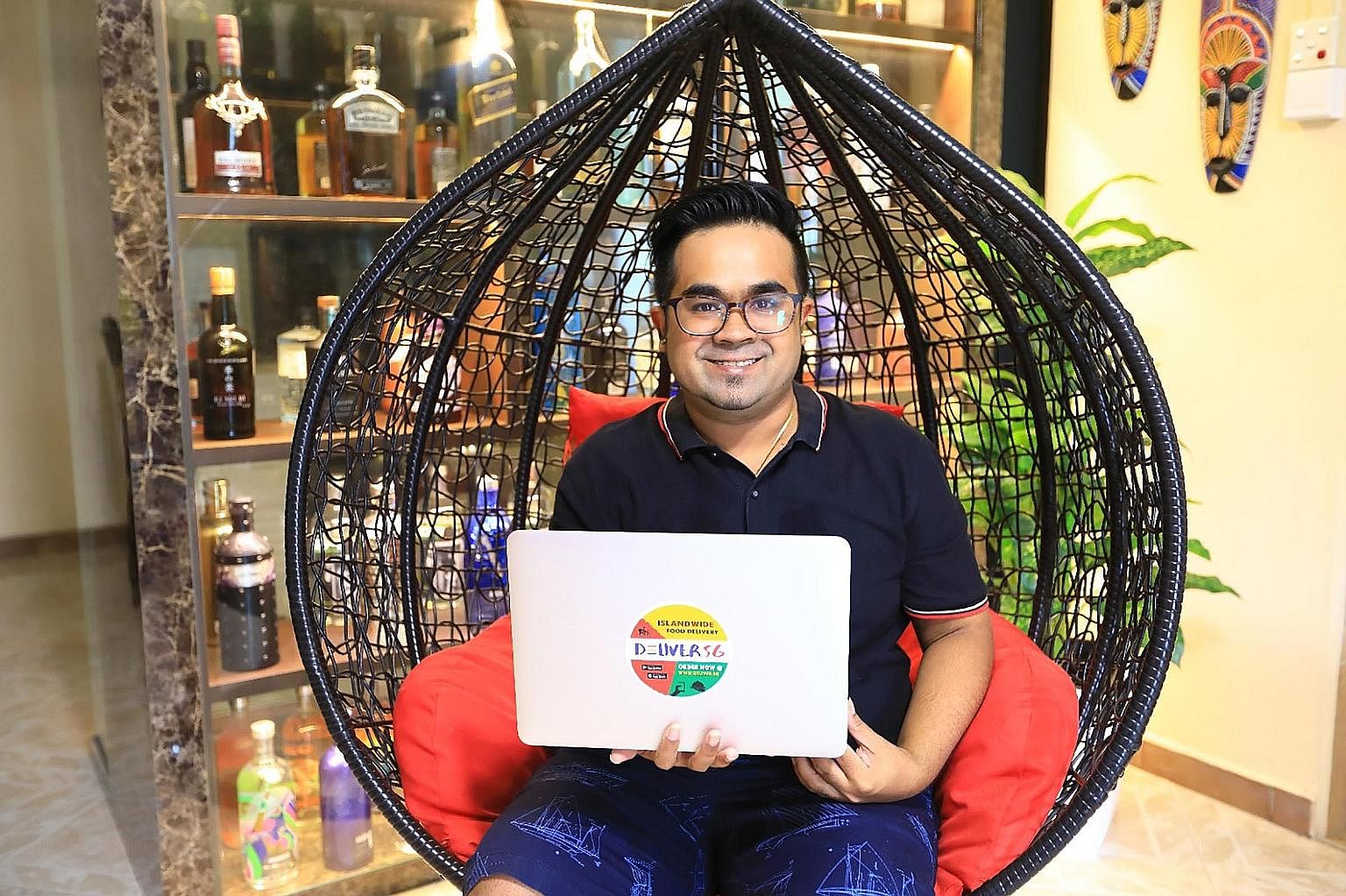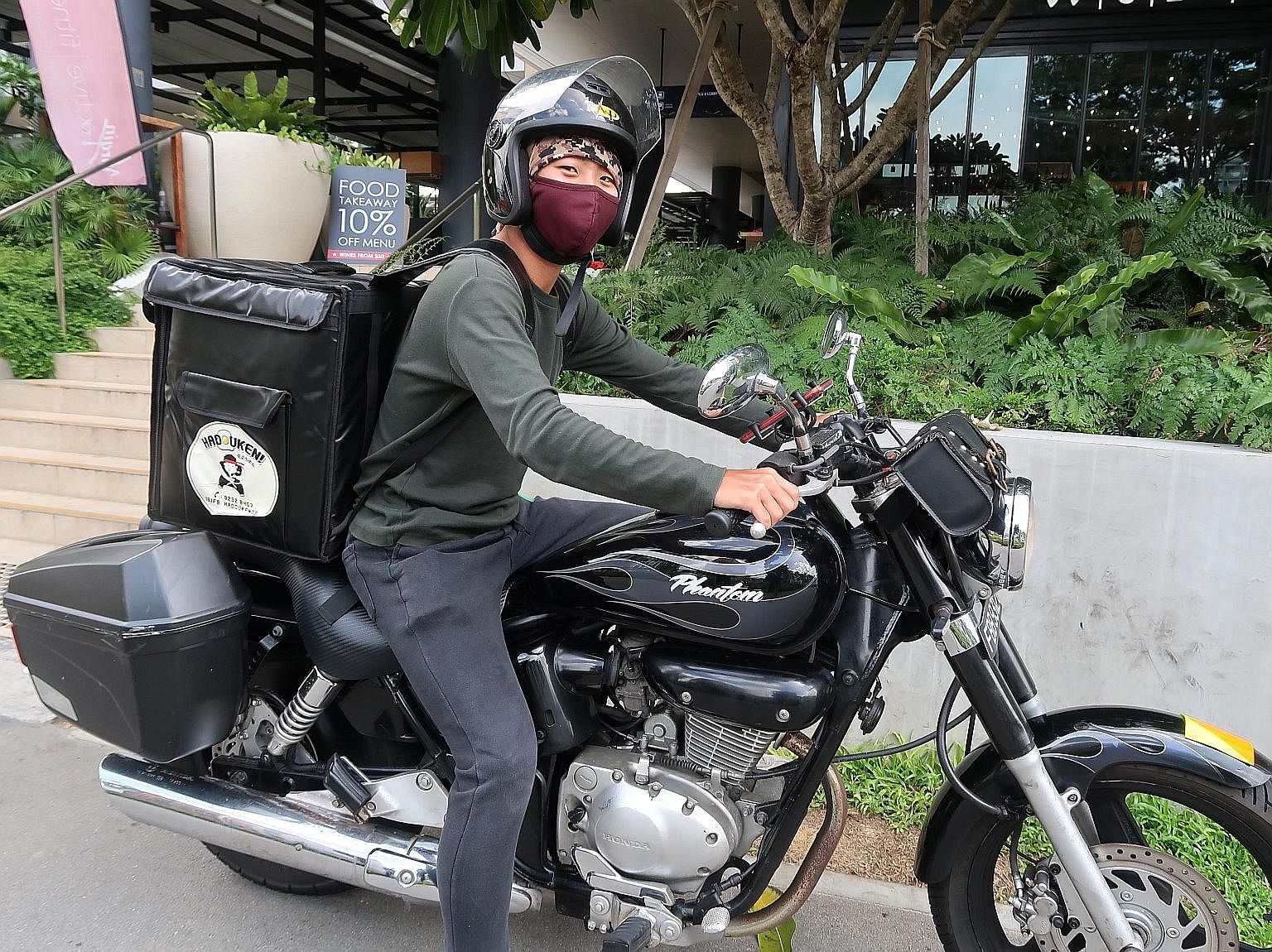Last month, Mr L. T. Lin ordered his family's dinner online. He scrolled through using his phone and settled on three packets of curry noodles.
To his surprise, when the food arrived, an extra box of beef on rice was tucked within the bag.
On another occasion, the 45-year-old ordered wonton noodles - and was given 12 packets of crispy pork lard along with it.
An hour later, the delivery rider returned to pick up the misdelivered lard.
Mr Lin's experience, with a new delivery platform that sprang up in recent months to ride the surge in demand during the circuit breaker period, is indicative of the food delivery landscape today: more choices, but patchy quality.
Beyond the Big Three players - Foodpanda, Deliveroo and GrabFood which entered the market in 2012, 2015 and 2018 respectively - at least 10 new platforms have leapt onto the food-delivery bandwagon.
They range from those backed by high-powered entities to smaller outfits.
Two weeks ago, WhyQ partnered FairPrice Group and started Marketplace@WhyQ, which delivers food from foodcourts, coffee shops and restaurants.
Another is Pickupp Singapore, started by a Hong Kong-founded logistics company, which went into on-demand food delivery in March.
Even major property developer CapitaLand has muscled into the game, launching last month Capita3Eats, which delivers food from eateries in its malls.
Reservation platform Chope started offering delivery options from April 9.
Buy4u, meanwhile, was created by four friends - a property agent, a photographer, an events company owner and a printing firm owner - whose incomes were affected by the downturn, who get other friends to deliver for them. It was launched the week that the circuit breaker kicked in on April 7.
Even as the economy gradually opens up, with eateries possibly reopening for dining before the end of this month, some are clearly betting that the habit of ordering food online and having it delivered to one's doorstep is here to stay.
Tech firms Oddle and Butleric will be launching Oddle Eats and B28 respectively.
According to research firm Statista, Singapore's revenue in the online food delivery segment is expected to amount to US$464 million (S$647 million) this year.
With the increased competition, hungry consumers have far more choices and, in some cases, are paying less for their food deliveries.
There is also the fact that eateries are not at the mercy of the Big Three, which are known for their high commission fees.
But challenges also abound, from a limited pool of riders to food safety concerns.
OCBC Bank chief economist Selena Ling said: "Some competition is always good, if it drives down costs for consumers and the margin being extracted from hawkers and restaurants. But if it comes at a price of delays or order cancellations, then the quality of service suffers.
"This may be the period of adjustment and the market will try to find an equilibrium over time."
FIGHT FOR RIDERS
Among these start-ups, many do not have their own riders or drivers.
By contrast, GrabFood, Foodpanda and Deliveroo have their own teams of riders, numbering 10,000 for Foodpanda and 7,000 for Deliveroo. It is not known how many riders work for GrabFood.
Instead, the new platforms tend to use third-party transport firms, such as Lalamove and taxi and private-hire companies, to carry out the deliveries.
A Foodpanda rider earns an average of $7.50 a delivery. A GrabFood rider makes between $5.50 and $12 per delivery. Those with cars earn slightly more, from $7 to $16.
A spokesman for Lalamove, which has about 8,000 active drivers, said the firm provides riders and drivers to at least four online delivery platforms.
With many platforms tapping the same pool of delivery riders, it is inevitable that some deliveries are delayed or even cancelled during peak periods and special occasions, said restaurant consultant Naresh Kumar, 33, co-founder of Deliver.sg, which was launched in January.
Order mix-ups can also happen.
Deliver.sg, which has 140 restaurants on its platform, including Burger & Lobster and Antoinette, engages Lalamove to make deliveries.
"We don't have our fleet of riders. Logistics are hard to manage. We are new and we want to wait and see," said Mr Kumar.
He said whenever a food order is placed on Deliver.sg, the restaurant owner and Lalamove will be notified simultaneously. Usually, the restaurant has about 20 minutes to prepare the food, while Lalamove will assign a driver to pick it up.

But during occasions like last month's Mother's Day, some restaurants struggled to cope with the surge in orders, while Lalamove also could not assign drivers in time, resulting in order cancellations.
Mr Johan Ng, 35, a designer, moved to other platforms after using GrabFood.
He is delighted with the greater options available - including food delivered from his favourite hawker centres, but has had a couple of bad experiences.
He once ordered duck kway teow and sugar cane juice from Kovan Hawker Centre.
"The food was to be delivered between 7pm and 8pm. By 8.30pm, my order was still not delivered, so I went out to buy it myself. Around 9.30pm, the food came but I had already had my dinner," he said. "The food was cold. I didn't even want to receive the food. It's ridiculous. In the end, I was forced to accept it."
There were also a few times when the delivery men spilled his drinks and soup, said Mr Ng.
For WhyQ, its staff - known as "hawker captains" - head to various food centres to collect orders from different stalls and bring the food to a distribution point at each food centre where delivery riders will pick them up.
WhyQ chief executive and co-founder Varun Saraf, who used to work as a management consultant, said WhyQ, which was launched in 2017, delivers about 3,000 meals daily now and has since tripled its pool of workers to 200 delivery riders and 100 hawker captains.
It engages contract workers who carry out services only for WhyQ during their shift.

But during the circuit breaker period, it engaged third-party delivery services from Lalamove and Zeek to fulfil orders.
To deal with the challenge, Pickupp Singapore, which started out making islandwide deliveries for bakeries, florists and frozen-food sellers using its fleet of three vans, has been engaging freelancers.
Its chief operations officer Lee Chee Meng said he now has a database of 11,000 active delivery men and women he can tap to do food-related deliveries, which range between 100 and 3,000 a day.
FOOD SAFETY
One question that has arisen is whether these new players have the resources to ensure that food is transported safely.
At Foodpanda, for instance, food must be delivered within the hour. Riders are trained on food handling and hygiene practices and encouraged to clean and air their food storage bags thoroughly after each shift.
"Every three months, riders will need to report to our hubs for quality checks and to ensure that their equipment remains sanitary. They are also strictly reminded to never handle unpackaged food," said a spokesman.
Some of the newer platforms told The Sunday Times they do not provide any thermal bags to riders now, but plan to do so in the near future.
They also tend to have a longer delivery time frame - up to two hours.
It is for this reason that some restaurants eschew the platforms and choose to carry out deliveries themselves.
Mrs Joni Ong of high-end Japanese restaurant Shinji by Kanesaka said it serves a lot of raw fish and the food would be transported in cooler boxes with packed ice.
Mrs Ong and two of her restaurant managers with cars make the deliveries themselves. To fulfil the orders on Mother's Day, the restaurant's chefs rode in private-hire cars.
Restaurant chain Tipsy Collective gets seven of its staff with motorcycles to do the deliveries.
"We understand that serving warm food is crucial in all deliveries. Therefore, we have implemented a heating lamp at our packing station and we also use a thermal delivery bag," said its co-founder Derek Ong.

LOWER FEES
With the influx of players, some have been slashing commissions to attract more eateries to list on their platforms.
This has been a big plus for eateries which have long complained about the Big Three taking a hefty cut - up to 35 per cent - of their earnings.
In April, about 8,000 restaurant owners and customers signed a petition protesting against their high commission fees.
Mr Kumar's Deliver.sg, for one, takes no commission. Instead, it raises food prices by about 10 per cent, and pockets the extra.
He is also more flexible about who pays the delivery fee, which ranges from $10 to $20.
Sometimes, it is split between consumers and restaurants; at other times, restaurants may absorb it if consumers spend beyond a certain amount. Or, to encourage consumer spending, Deliver.sg may help foot part of the cost.
Marketplace@WhyQ does not charge its vendors any commission or set-up fee either. Instead, it marks up food prices by 6 per cent.
As for WhyQ's separate hawker platform, revenue is derived from a combination of a delivery fee of $1.50 per meal paid by the customer, as well as a cut of the takings from hawkers.
If hawkers cannot pay a commission, WhyQ would then mark up their food prices, which are paid by the customers, said Mr Saraf.
WILL THEY SURVIVE COVID-19?
At one point, Singaporeans will return to eating at hawker centres, coffee shops and restaurants.
Will these platforms still be around after that?
Mr Hau Koh Foo, director of Singapore Management University Institute of Innovation and Entrepreneurship, thinks not.
Paying for food to be delivered to homes is unaffordable for many people, he noted, referring to the high delivery costs.
"So, who will succeed? If prices can't go down, only the big players will survive because they can use this business to augment their other businesses."
One of the new players hoping to circumvent this is Mr Ron Lee of Butleric, which is launching B28 at the end of the month.
Aside from providing an online food-ordering platform, he intends to provide another service to eateries: analysing customer data and helping them grow their business.
Mr Lin, who now orders food from three different apps, said he would continue to use delivery services even when life returns to normal.
"I am lazy to go out to buy food, plus delivery apps provide more options for me to choose my favourite food from famous stalls, like Ah Heng curry chicken beehoon mee from Hong Lim Food Centre and chicken rice from Maxwell Food Centre," said Mr Lin.
"The food is good, trust me."













